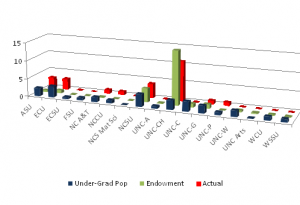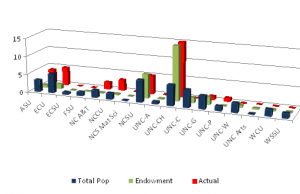Before we get going, I strongly suggest that you ‘set the table’ for today’s entry by reading this fantastic piece that should be mandatory of every taxpayer in the state of North Carolina.
If there is one thing the current athletic cheating and academic fraud scandal at the University of North Carolina at Chapel Hill has brought to light is exactly how “in the hole†the UNC Board of Governors are for their beloved Tar Heels. Why is the Board of Governors so unconcerned with getting to the bottom of this complex story while their “flagship school†is publicly drug through the mud? Where is the outrage? Why aren’t members on the board speaking up like their predecessors so willfully spoke against NC State twenty-one years ago when allegations of impropriety arose? Especially in light of the fact that NC State’s allegations were significantly less egregious than what has already been proven to have transpired in UNC’s Athletics Department?
The answers to ^these questions – and many more like them – have been obvious to most of us for a long time…but you won’t see any changes in the laughably sad power structure of this state until people start pressing for more answers, consistency and accountability from state lawmakers and the University of North Carolina system.
Like the main blog here at SFN, our our message forums have buzzed with information regarding UNC’s multi-pronged athletic and academic scandal since things started unraveling earlier in the year. One thread that has garnered significant attention over the last month is this one that scrutinizes the very strong pro-UNC-Chapel Hill composition of the University system’s Board of Governors.
Even if one entertains the arrogant Carolina-centric notion that the self-anointed status as the UNC system’s ‘flagship’ is appropriate, I would posit that does not translate into an implicit presumption that all of the other universities in the UNC system are crap schools that can just be ignored and overlooked. Â
Consider our beloved NC State. Â North Carolina State University has ranked in the national top 20 universities in the following disciplines over the last two years:
1. Graduate Programs
2. Agricultural Engineering
3. Biological Engineering
4. Veterinary Medicine
5. Textiles
6. Chemical Engineering
7. Environmental Engineering
8. Industrial Engineering
This does not include other honors such as NC State’s ranking as the 10th best public university in research (without the aid of a medical school); the 7th in the nation in industry-funded research; and the 10th best value in the country as ranked by Kiplingers. The point is that NC State brings plenty of national prestige and recognition to the state of North Carolina, not to mention a lot of industry-created jobs and an influx of money into the state economy.
On that note, let’s consider the current make-up of the University of North Carolina Board of Governors.  The current Board includes 11 undergraduates from UNC-Chapel Hill. Compare that to the second most represented institution – NC State with only 4 representatives, followed by East Carolina and Appalachian State (representatives each). This chasm of representation ultimately creates a gross bias towards many things ‘UNC-Chapel Hill’. The graphic below compares the number of current seats on the BOG by undergraduate population of each institution and their endowments. (Graphic can be expanded by clicking).
As you can see, the Board of Governors seems to actually follow undergraduate population fairly well… except for Carolina.  While some smaller institutions may not be represented at all (such as UNC-W or WCU), ECU, ASU, NC A&T, NCCU, and NC State seem to actually follow a population-based representation scheme.  The only anomaly is Carolina who would, theoretically, only have 3 representatives instead has 11 if seats were awarded via population  It appears that everyone must “play fair†with respect to population except for Carolina who feels obliged to follow a more economically-based representation scheme.
Bear in mind that typically the university someone attends as an undergrad is typically where their loyalties lie. A great example of this was observed during the fight between UNC-Chapel Hill and East Carolina when the Pirates wanted to plunder the Tar Heel’s monopoly on dentists by establishing their own dental school.  During this political struggle, representatives from UNC-Chapel Hill were quoted as arguing against ECU receiving their own dental school by explaining dental schools smaller than 800 students tend to be ineffective and ECU’s school would be far too small to be efficient at producing dentists.  These statements and this position resulted in ECU being denied a dental school in 2002.  For your information, UNC-Chapel Hill’s dental school has 320 students… but that wasn’t the point the Board of Governors wanted to make. (Since then, ECU has successfully made another bid for a dental school and won.)
To avoid one-sided fist-fights and politically biased battles like this, how could a Board of Governors be set up to ensure all member institutionals have some form of equality or, at the very least, accurately represent the students, teachers, faculty and community they are to govern?  The following comes from my post in the SFN forums:
(1) Equal respresentation. This isn’t necessarily a bad idea because it gives smaller institutions a bigger voice to coordinate efforts and resources with bigger institutions to help improve themselves. A school system is like a city: the nice places only look so good if the majority of your community is full of slums. Boosting our periphrial institutions will make the whole body of work better. RESULT: All institutions equal.
(2) Weighted representation based on population. This would be the most “goal oriented” way to set up your BoG. It ensures that the BoG represents what the people in North Carolina want to study and where at. There could be an implied drawback here due to allowing students to effectively decide the landscape of the BoG. It’s a pretty common preception that most college students have poor ideas of what they want to do or chose a university based on less-than-credible rationales (like “they have good sports” or “my girl friend goes there”). Despite that, there is still obvious benefit in ensuring that the BoG concern themselves with the matters that a majority of their “customers” are concerned about by setting their numbers relative to each institution based on enrollment. RESULT: NCSU leads the Board followed by UNC-CH, ECU, UNCC, et al
(3) Weighted representation based on endowement. An argument could be made that the BoG should follow the money because it is a sound business plan designed to follow the money. The obvious benefit is that you let who is “good” with money make the majority decision in hopes of benefiting the whole. Unfortunately, this most likely would lead to a BoG less concerned with improving the prestige and proficiency of it’s allied institutions and more concerned with reducing costs (via cutting spending that funds scholarships and student/academic programs) and increase renevue (through higher fees and tuition rates). [The one exception would be the majority “owner” of the Board which would obviously get top cuts off budgets and financial allotments.] This most closely resembles the situation going on in the State of North Carolina now. RESULT: You’re living it baby. Carolina as top dog followed by NCSU, ECU…
The table below shows how the Board of Governors would be comprised if representatives’ undergraduate degrees were fairly distributed based on either population or endowment.  Note that, as shown in the graphic, every university appears to reasonably follow a population-based representation besides Carolina.
| University | Actual Reps | Based on… | |
| DEGREE | ENDOW | ||
| ASU | 3 | 2 | 0 |
| ECU | 3 | 3 | 1 |
| ECSU | 0 | 0 | 0 |
| FSU | 0 | 1 | 0 |
| NC A&T | 1 | 1 | 0 |
| NCCU | 1 | 1 | 0 |
| NCSSM (HS) | 0 | – | – |
| NCSU | 4 | 3 | 4 |
| UNC-A | 0 | 1 | 0 |
| UNC-CH | 11 | 3 | 16 |
| UNC-C | 0 | 3 | 1 |
| UNC-G | 1 | 2 | 1 |
| UNC-P | 1 | 1 | 0 |
| UNC-W | 0 | 2 | 0 |
| UNC Arts | 0 | 0 | 0 |
| WCU | 0 | 1 | 0 |
| WSSU | 0 | 1 | 0 |
Â
The argument could be made that the Board of Governors isn’t some sort of undergraduate-only party.  I mean, to be completely fair, we have to look at graduate degrees too, right? Well, we here at StateFansNation thought of that. Below is a graphic that represents how a notional Board of Governors would look based on total institution population and endowment and compares them to the total number of degrees represented on the Board regardless of graduate or undergraduate status.
Similarly, here is the same data tabulated.
| University | Actual Reps | Based on… | |
| DEGREE | ENDOW | ||
| ASU | 4 | 3 | 1 |
| ECU | 5 | 5 | 1 |
| ECSU | 0 | 1 | 0 |
| FSU | 0 | 1 | 0 |
| NC A&T | 2 | 2 | 0 |
| NCCU | 3 | 2 | 0 |
| NCSSM (HS) | 0 | 0 | – |
| NCSU | 5 | 6 | 7 |
| UNC-A | 0 | 1 | 0 |
| UNC-CH | 21 | 6 | 27 |
| UNC-C | 0 | 5 | 1 |
| UNC-G | 1 | 4 | 2 |
| UNC-P | 1 | 1 | 0 |
| UNC-W | 0 | 3 | 1 |
| UNC Arts | 0 | 0 | 0 |
| WCU | 0 | 2 | 0 |
| WSSU | 0 | 1 | 0 |
Â
Well…well…well. What do you know? The exact same trend occurs! Again, it appears that all of the schools in the UNC system are allocated BOG seats along proportional student populations EXCEPT the folks from Chapel Hill!? I’m starting to get a better understanding of this “Carolina Way” stuff.
The UNC Board of Governors is responsible for “the general determination, control, supervision, management, and governance of all affairs of the constituent institutionsâ€. This means that even though they are not currently set up in a way that shows an effort to represent the interests of all member institutions, their mission begs them to ensure the needs and “affairs of the constituent institutions†are heard and addressed.  It’s very similar to the politics of our nation: even non-state territories are given representation in our government since our government makes decisions on their behalf.  Similarly, it is simply an abuse of power for there to be such a lop-sided influence in the decision making process favoring one institution over another.
You can’t fault UNC-CH for being a ‘victim’ of the system that their alums in power at the state legislature created, but can you fault them for continuing to perpetuate the image of the “ruling eliteâ€.  If it never dawned upon the geniuses in state government that maybe they should more accurately represent the needs of all member institutions, consider this as their notice.  It’s time that each member institution grumbles louder about this kind of mis-representation in order to elevate the prestige and performance of all of the system’s Universities.





You must be logged in to post a comment.